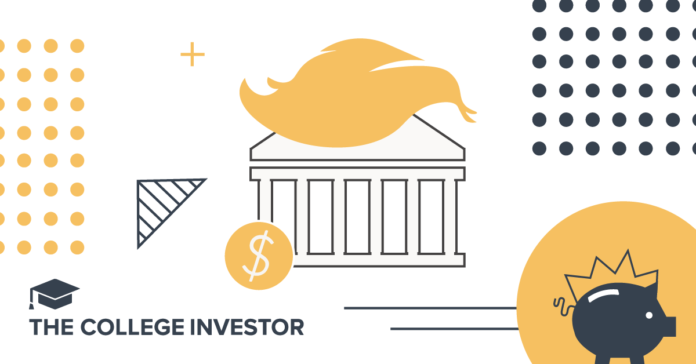President Trump made some major changes to student loan forgiveness programs – and most people don’t know it. Combine that with the proposals rolled out by Education Secretary Betsy DeVos, and the Trump presidency was mired with student loan controversy.
Let’s break down the changes Trump’s administration has done with student loan forgiveness, and then talk a little bit about the proposals that he’s made for his next presidency.
Remember, proposals are just that – proposals. It doesn’t mean that these changes will go into effect. However, it’s a great reminder for people with student loans that it might be a good time to take action on your debt if you’ve been neglecting it.
With most proposals, they take effect for future loan borrowers – that means, if you’re in a repayment plan or student loan forgiveness plan right now, you’ll likely be grandfathered in.
It sounds like it could be confusing, but it doesn’t have to be. You can sign up for these programs for free at StudentLoans.gov.
Okay, so let’s talk about the potential changes to student loan forgiveness programs.
Emergency Waiver On Student Loan Payments and Interest
Update: On March 13, 2020, as part of his emergency declaration for the coronavirus, Trump announced that he would be freezing/waiving student loan interest AND payments on student loans held by the Federal government. President Biden extended the waiver through August 30, 2023.
It’s important to note that this is pretty limited for borrowers. Loans held by the Federal government refers to “Direct” student loans and some FFEL loans, not all FFEL loans, Perkins loans, or private loans. That means if you have FFEL loans or private loans, you don’t qualify for this waiver of interest.
Also, any loans in collections will have collection activities suspended for the time being.
Finally, if you’re going for loan forgiveness programs like Public Service Loan Forgiveness, the payments “missed” during this pause will still count towards your eligible payments.
Verdict: Good.
This program is very helpful for borrowers trying to navigate the pandemic. By pausing student loan payments and interest, Trump has freed-up much needed spending in people’s budgets. Yes, there are other ways to help, but this is an easy solution to help borrowers.
For borrowers losing work and income due to the coronavirus, it’s essential that you immediately update or apply for income-driven repayment with an income that reflects what you’re currently earning (especially if it’s $0). This is the best course of action to not go into default on your student loans after the Covid-19 student loan deferment ends.
See our full guide here: What happens to your student loans during quarantine or lock-down.
Tax Free Death And Disability Student Loan Discharge
We’ve discussed before in our article on secret ways to get student loan forgiveness that, unless you’re in a qualifying program, most student loan forgiveness and student loan discharges are considered taxable income.
That means if were to get $50,000 in student loans forgiven, it is considered income. If you made $35,000 working, your total income for the year would now be $85,000. The result? A higher tax bill. Borrowers could see their tax bills rise by $10,000 or more!
To make matters worse, if you’re getting your loans discharged due to total and permanent disability, this “income” could disqualify you from aid programs that you might rely on.
However, Trump tax plan, known as the Tax Cuts and Jobs Act, eliminated the taxability of student loan discharge on people who get it for Death or Total and Permanent Disability. That means, if you are getting student loans discharged on death or disability, you no longer will face a tax burden (or your family won’t).
It’s important to note that this provision only went into effect on January 1, 2018 – and so any loans discharged in 2017 will still face taxes. Furthermore, this provision is set to expire in 2025 unless Congress renews it.
You can learn more about disability discharge here.
Verdict: Good.
We think this is a very good change to student loan forgiveness that is common sense.
Note: Furthermore, on August 21, 2019, Trump directed both the Secretary of Education and Secretary of Veterans Affairs to find a way to make this automated for veterans who qualify. That would be a huge win for the 50,000 or so veterans who should get their loans forgiven.
Tuition And Fees Deduction Eliminated
The tuition and fees deduction has been eliminated under the Tax Cuts and Jobs Act. The tuition and fees deduction was actually an extender that expired at the end of 2016. The tuition and fees deduction allowed taxpayers to reduce their taxable income by up to $4,000.
However, while there were proposals to eliminate or change other education tax credits – such as the American Opportunity Tax Credit and the Lifetime Learning Tax Credit, those tax credits stay the same under the new law. However, there are income limits to these education tax credits, so the tuition and fees deduction provided some relief to high earner tax payers.
Verdict: Mixed.
While we’re sad to see this tax deduction go, there are others still available and this was mostly taken advantage of by high earners.
Trump Student Loan Forgiveness Previous Proposals
During his last term as President, he did make some proposals that were never enacted to even taken very far.
Whether you’re for or against these changes, you need to know what they are and what they could mean because he’s spoken about them before. Then you should voice your concerns to your representative in Congress.
Elimination Of Public Service Loan Forgiveness (PSLF)
President Trump, along with Betsy DeVos, have called for the elimination of Public Service Loan Forgiveness (PSLF) on several occasions. PSLF is one of the top ways to get student loan forgiveness in the United States.
In his first budget proposal for 2018, he attempted to defund PSLF. This raised a series of legal questions (because whether there is money or not, it’s still the law, so what would the Department of Education do), and eventually the proposal was dropped.
However, in his next budget for 2019, Trump has once again proposed eliminating Public Service Loan Forgiveness.
It’s important to note that the proposed changes would apply to new loans after July 1, 2019. So, it currently appears that those with existing loans would be grandfathered in.
Changes to loans would apply to borrowing after July 1, 2019, not including those loans provided to borrowers to finish their current education.
Verdict: Bad.
You will have fewer people pursuing work in public service, government, law enforcement, teaching, and more. Given many of these fields require a degree, it could be difficult for highly qualified people to get a degree and then work in these lower income fields that are valuable to the United States as a whole.
Elimination Of Subsidized Student Loans
Trump has also proposed the elimination of subsidized student loans in his 2019 budget proposal. Subsidized student loans provide student loan borrowers with significant assistance – with the government paying for interest accrued during school. This can result in significant savings for borrowers.
The government issued 5.7 million subsidized student loans in the 2016-2017 school year. These loans go towards students with a financial need, based on filling out the FAFSA.
Verdict: Bad.
These loans only go towards students who have a financial need. They will still borrow to pay for college, but now it will be more expensive.
Eliminate Most Repayment Plans In Favor Of A Single Income-Driven Repayment Plan
President Trump has proposed the elimination of all the income-driven repayment plans (IBR, PAYE, RePAYE, ICR) and replace them with a single income-driven repayment plan.
This new repayment plan would cap borrower’s monthly payment at 12.5% of their discretionary income. It would also provide for student loan forgiveness at 15 years for undergraduate borrowers, and 30 years for graduate borrowers.
Trump has made comments that he would like the government to cover the cost of student loan forgiveness under his new plan – which leads us to believe that it would be tax free student loan forgiveness. However, this has not been clarified, and it would be different than the current existing income-driven repayment plan programs.
Verdict: Mixed.
Some borrowers will benefit by seeing their income driven repayment amount drop to 12.5%, while others will lose by seeing it rise from 10%. Also, the repayment term of 15 years could benefit a lot of undergraduate borrowers, but the 30 year graduate term is longer than all existing plans today. Finally, the forgiveness aspect is important – a shorter repayment term could mean bigger forgiveness, but if that’s taxable, that could be harmful.
Lifetime Loan Limits
In the most recent budget proposal, President Trump announced a vague proposal on lifetime limits for graduate students and Parent PLUS loans.
Currently, there are lifetime loan limits for undergraduate borrowers and certain graduate borrowers, but no limits for PLUS loans for parents or graduates. This has created some borrowers having over $1,000,000 in student loan debt.
We agree that lifetime loan limits are a good thing, which not only would protect borrowers, but could lower the aggregate costs of higher education.
However, it is yet to be seen what the limits would be, and they could be so high that they don’t fix anything.
Verdict: Good.
I believe that lifetime loan limits would protect borrowers, help lower college costs, and more. There is a potential downside on limiting certain groups of borrowers, but if the limits are created properly, this is a good thing.
Related: The House does have a bill proposal with loan limits called the College Cost Reduction Act.
Allow Student Loans To Be Discharged In Bankruptcy
This proposal comes from the Department of Education, which announced that it was seeking comments on how to determine “undue hardship” to allow student loans to be discharged in bankruptcy.
It’s important to know the history of this. Before 1998, student loans could be discharged in bankruptcy after the seventh year of repayment. However, after 1998, student loans were prohibited from being discharged in bankruptcy except in cases of “undue hardship”
However, Congress never defined what undue hardship meant, and so the courts have taken it upon themselves to decide – and it’s not always uniform.
Regardless, undue hardship is a very high bar to clear – because you essentially have to prove that you’d never be able to afford your loans, even on an income driven plan, for the rest of your life. Given that income-driven plans offer such low payments based on income, it’s tough to prove.
It’s why many people simply write off the ability to get student loans discharged in bankruptcy, even though it’s theoretically possible.
Verdict: Mixed.
For some borrowers, the ability to get out from un-payable student loan debt would be a blessing. Just read some of the comments on this article. There are clear cases where student loan debt is un-payable and is an undue hardship.
However, changing the rules around bankruptcy and student loan debt could seriously disrupt the marketplace for student loans – making it more difficult and more expensive for borrowers to get a loan. Given that the collateral for student loan debt is future borrower earnings, making this collateral less secure will drive up prices.
Elimination Of The Student Loan Interest Deduction
In the Tax Cuts and Jobs Act, Trump originally proposed eliminating the student loan interest deduction. While it was saved in the final bill, it doesn’t mean that Trump still wants to see it eliminated.
The student loan interest deduction provides up to $2,500 in deduction of the interest you paid on a student loan.
While this is a handy savings, it does phase out at relatively low income levels.
Verdict: Good.
I believe that the student loan interest deduction is a misaligned incentive that doesn’t do anything, but does cost taxpayers money.
What Should Borrowers Do Today?
If you’re a borrower concerned about these changes, there are a few things that you can do today to at least be prepared, if not proactive.
First, ensure that you know what programs you’re on with your student loan debt. You should know your repayment plan, know your forgiveness program if you’re going for it, and know your options.
Second, you need to ensure that you’re current on your loans and not in student loan default. If you are, look at rehabilitating your student loans as soon as possible to get on track. If Trump does change student loan repayment plans, it could be more difficult for you if your loans are in default.
Finally, write or contact your members of Congress who would likely have to vote on any changes. Express to them both your concern and what you need from them as your legislator.
You can also consider professional help. Remember, you can do everything with your Federal loans for free at StudentAid.gov.
Final Thoughts
It can be scary to think about all of these different student loan repayment plans and student loan forgiveness programs changing.
However, plans have changed before, and they will again in the future. Trump’s student loan forgiveness plans and proposals are a little scary, but they are likely only going to apply to future student loan borrowers. And remember, even if the Department of Education is eliminated, your loans are still going to function normally.
As such, if you have student loans today, you need to take action and start making progress on them.
Create your very own Auto Publish News/Blog Site and Earn Passive Income in Just 4 Easy Steps







